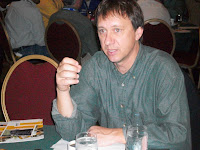
Many of us in the landscape industry are grappling with the concept of sustainability, something that I've been researching and attempting to understand for more than a year.
The more I learn about sustainability as it relates to the landscape/lawn service trade the more I'm convinced that we have to embrace it from an environmentally responsible AND a business standpoint.
That was one of the dominant themes at PLANET's Green Industry Conference (GIC) in Louisville this past week. Lots of presenters at GIC have been sharing information on the topic. Their messages all start with the same introduction, at least when it comes to the "green" portion of sustainability -- it's not a passing fad.
Tim Schauwecker, program coordinator at Mississippi State's excellent Landscape Management program, reinforced just that point. Tim was the moderator at one of the 80 or so round tables at the Thursday morning Breakfast of Champions event at PLANET's GIC. Me and four other contractors spent more than an hour learning about what's coming down the road in terms of sustainability, spending much of our time getting up to speed with LEED and the Sustainable Sites Initiative that the American Society of Landscape Architects, the Lady Bird Johnson Wildflower Center and the U.S. Botanic Garden are preparing for its eventual incorporation into LEED.
LEED is program run by the U.S. Green Building Council to make buildings more energy efficient, healthy for occupants and friendly to the environment. It is having a huge impact on the construction trades.
SSI may have an equally large impact on the landscape/lawn service industry, once SSI gets paired with LEED. Keep your eyes on its progress.
But, back to Tim and what's going on with his program. He says that the 70 or so students he has contact with at MSU in Starkville, MS, are on top of this sustainability issue like gnats on a ripe peach. Learning the "green" way of providing products and services is becoming a bigger piece of their educational experience, he says.
This leads me to wonder that as they (and students from other progressive horticulture and landscape programs), start their careers within our companies and/or create their own companies, how much farther they will drive this issue of sustainability, within our industry, especially its environmental components.
There is a lot of bright, ambitious young students in these programs. What impact is this educated but inexperienced talent having on your companies?
-- Ron Hall

